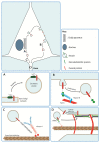Axon-Targeting Motifs: Mechanisms and Applications of Enhancing Axonal Localisation of Transmembrane Proteins
- PMID: 35326388
- PMCID: PMC8946247
- DOI: 10.3390/cells11060937
Axon-Targeting Motifs: Mechanisms and Applications of Enhancing Axonal Localisation of Transmembrane Proteins
Abstract
Neuronal polarity established in developing neurons ensures proper function in the mature nervous system. As functionally distinct cellular compartments, axons and dendrites often require different subsets of proteins to maintain synaptic transmission and overall order. Although neurons in the mature CNS do not regenerate throughout life, their interactions with their extracellular environment are dynamic. The axon remains an overall protected area of the neuron where only certain proteins have access throughout the lifespan of the cell. This is in comparison to the somatodendritic compartment, where although it too has a specialised subset of proteins required for its maintenance, many proteins destined for the axonal compartment must first be trafficked through the former. Recent research has shown that axonal proteins contain specific axon-targeting motifs that permit access to the axonal compartment as well as downstream targeting to the axonal membrane. These motifs target proteins to the axonal compartment by a variety of mechanisms including: promoting segregation into axon-targeted secretory vesicles, increasing interaction with axonal kinesins and enhancing somatodendritic endocytosis. In this review, we will discuss axon-targeting motifs within the context of established neuron trafficking mechanisms. We will also include examples of how these motifs have been applied to target proteins to the axonal compartment to improve both tools for the study of axon biology, and for use as potential therapeutics for axonopathies.
Keywords: axon transport; axon-targeting motif; neuronal polarity; protein trafficking; secretory pathway; somatodendritic; transcytosis; transmembrane protein.
Conflict of interest statement
The authors declare no conflict of interest.
Figures


Similar articles
-
Selective microtubule-based transport of dendritic membrane proteins arises in concert with axon specification.J Neurosci. 2014 Mar 19;34(12):4135-47. doi: 10.1523/JNEUROSCI.3779-13.2014. J Neurosci. 2014. PMID: 24647935 Free PMC article.
-
Constitutive activation drives compartment-selective endocytosis and axonal targeting of type 1 cannabinoid receptors.J Neurosci. 2006 Mar 22;26(12):3141-53. doi: 10.1523/JNEUROSCI.5437-05.2006. J Neurosci. 2006. PMID: 16554465 Free PMC article.
-
No Pasaran! Role of the axon initial segment in the regulation of protein transport and the maintenance of axonal identity.Semin Cell Dev Biol. 2014 Mar;27:44-51. doi: 10.1016/j.semcdb.2013.11.001. Epub 2013 Nov 14. Semin Cell Dev Biol. 2014. PMID: 24239676 Review.
-
Pathway selection to the axon depends on multiple targeting signals in NgCAM.J Cell Sci. 2008 May 1;121(Pt 9):1514-25. doi: 10.1242/jcs.022442. Epub 2008 Apr 14. J Cell Sci. 2008. PMID: 18411247
-
Axonal transport and neuronal transcytosis of trophic factors, tracers, and pathogens.J Neurobiol. 2004 Feb 5;58(2):295-314. doi: 10.1002/neu.10315. J Neurobiol. 2004. PMID: 14704960 Review.
Cited by
-
Lifelong regeneration of cerebellar Purkinje cells after induced cell ablation in zebrafish.Elife. 2023 Apr 12;12:e79672. doi: 10.7554/eLife.79672. Elife. 2023. PMID: 37042514 Free PMC article.
-
Extracellular Vesicle Metabolomics Holds Promise for Adult Axon Regeneration.Metabolites. 2025 Jul 4;15(7):454. doi: 10.3390/metabo15070454. Metabolites. 2025. PMID: 40710554 Free PMC article. Review.
References
Publication types
MeSH terms
Substances
Grants and funding
LinkOut - more resources
Full Text Sources
Research Materials

